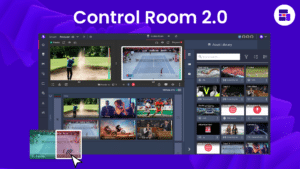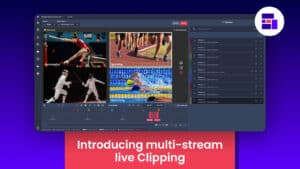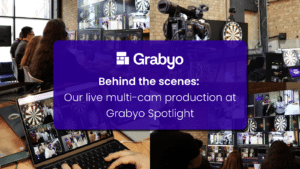How will digital media production and marketing shape up in 2019?
2019 promises to be an exciting year for the digital media industry. Shifting consumption habits present both challenges and opportunities for broadcasters, rights holders and content creators competing to capture digital audiences in a crowded media landscape.
Consumer-driven innovation by new players in the OTT streaming and media rights market, coupled with advances in technology and emerging commercial opportunities in digital media, signal a big year ahead.
Innovation is key: AI and metadata
The potential of AI to revolutionize content management and digital media production is well-documented, but this year we expect to see moves towards more holistic technology solutions.
Video production workflows are one of the key areas that will benefit from AI, as long as technology supports, rather than replaces, human editors and creatives. Using machine learning, editors will be able to take better control of their content libraries, using computer vision to index and extract metadata to make the most of their archives. Video quality control can also become autonomous, once machines are able to recognize and react to human-defined control parameters. The same is true for encoding – Netflix and YouTube are already using deep learning technology to ensure machines do the heavy lifting and react in real-time to various media inputs – we expect this to become common practice over time.
It is hard to envision fully automated content creation coming to the fore in 2019. Automated video clipping is well established in sports broadcasting, where definable triggers, such as goals, can be captured. But AI still lacks a deeper contextual understanding, which means it will fail to recognize the moments that give meaning and insight to stories across most types of video. The best content evokes an emotive response, whether news, sports, entertainment or music. Without this, content is not likely to cut through the noise.
Cloud production for digital media
Media organizations are now embracing cloud solutions as a robust backbone for scaling and innovating their offerings. Cloud-based video production is helping businesses to maximize their resources by reducing the limitations of traditional broadcast infrastructures and replacing legacy systems.
Coupled with the upcoming network upgrades for 5G, remote production and collaborative working will free content creators from these restraints. EE and BT Sport’s 5G-based production of the Wembley Cup in 2018 highlighted what’s possible – the footage was shot using mobile camera units in backpacks and carried by 5G to be remotely produced from across the city in London.
We will see many major events adopt this process once 5G is widely available. The challenges of bringing together multiple events or stories from various locations will be reduced and producers will have the freedom to be more creative and ambitious with content.

Video content is still king
As consumers gain access to 5G networks, latency and buffering will become less of a concern and video content consumption will continue its sharp increase across devices, both at home and on-the-go.
Live streaming will reach new heights of popularity in 2019 and more publishers will react by adopting it into their strategies. 80% of consumers already prefer to watch a live video stream than read a blog – this rises to 82% who prefer live over social posts. Video is also 79% more effective than photos and images for engaging consumers on social media. Video is not just a content proposition but a highly impactful medium for marketing and storytelling.
The community-based nature of live social video drives higher engagement which results in longer watch times and audience loyalty – content creators are already tapping into this trend by producing interactive live video with polls, displaying real-time comments and Q&As. Social audiences are looking for more choice and more participative experiences, which live video must offer in 2019.
We are able to reach engaged digital audiences on a number of devices and platforms with greater ease than ever before. Consumers are watching video on more devices and with an increase in connected TVs, tablets and larger smartphones on the market, this shows no sign of slowing through 2019 and beyond.
Where is the digital media market going?
The direct-to-consumer OTT market will be interesting to watch this year as Disney enters the fore with a brand-new service (Disney+) to compete with Netflix and Amazon Prime, both of whom have planned sizeable content budgets for the year ahead. The new Disney+ service is in addition to ESPN+ which launched in 2018 and already has more than 1m US-based subscribers paying $4.99 a month for live sports.
Social media platforms are expanding long-form content offerings too. Facebook’s new streaming platform, Facebook Watch, has begun licensing content from 21st Century Fox and is encouraging publishers to publish a broader range content to the platform. The capture of the Buffy the Vampire Slayer back catalogue is redolent of this shift in focus and the move towards content formats that are better suited to an older, 30yrs+ user demographic. Snap is also striking partnerships to bring long-form shows to its app.
As the competition for OTT subscribers heats up, we will see these platforms bolster their marketing strategies using social video – one of the most effective tactics in converting viewers to paying customers. By offering premium content on social media for free, organizations are able to raise awareness of their services while driving traffic to their own channels and platforms and driving key intent-to-purchase and conversion metrics.
Social media will be a key battleground on which audiences will be won and lost – expect to see much more short-form content published to these platforms. Quality should not make way for quantity, but it remains to be seen if digital teams have the right tools to compete in a such a fast-paced, consumer-centric media market.
2019 will be a year of efficiencies and focus. Producers will change processes and technologies to ensure workflows are optimized for digital production, and distribution teams can create and manage content efficiently. Modern consumers demand relevant content at the right time, so the winners will have to consistently innovate products and offerings to stand out from the crowd.
Related Blogs
Stay in touch.
Join over 10,000 media professionals and register to receive our monthly newsletter directly to your inbox!


















































